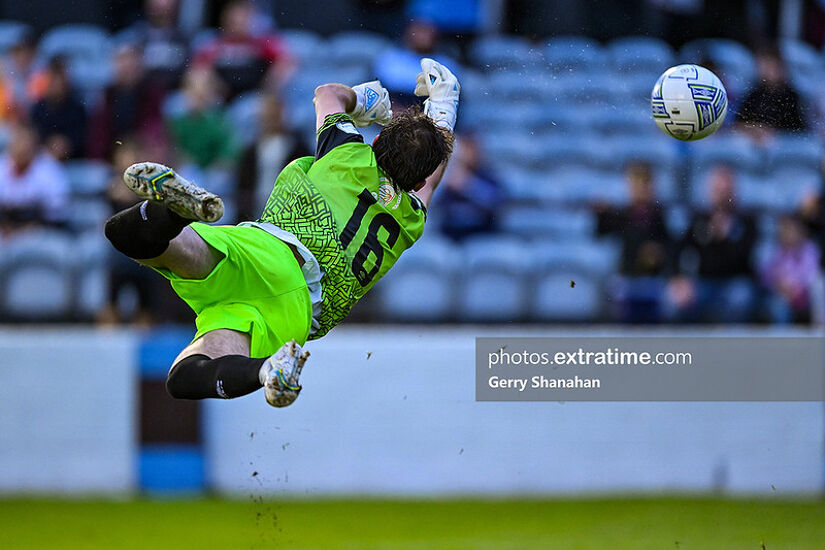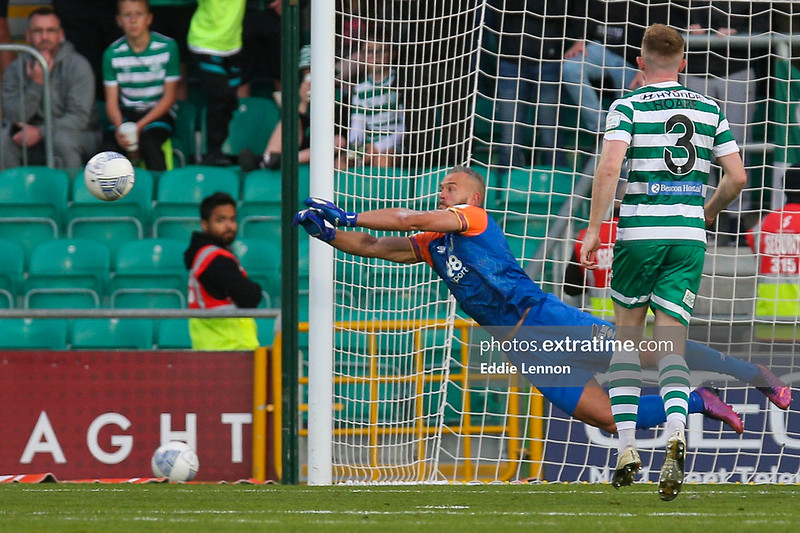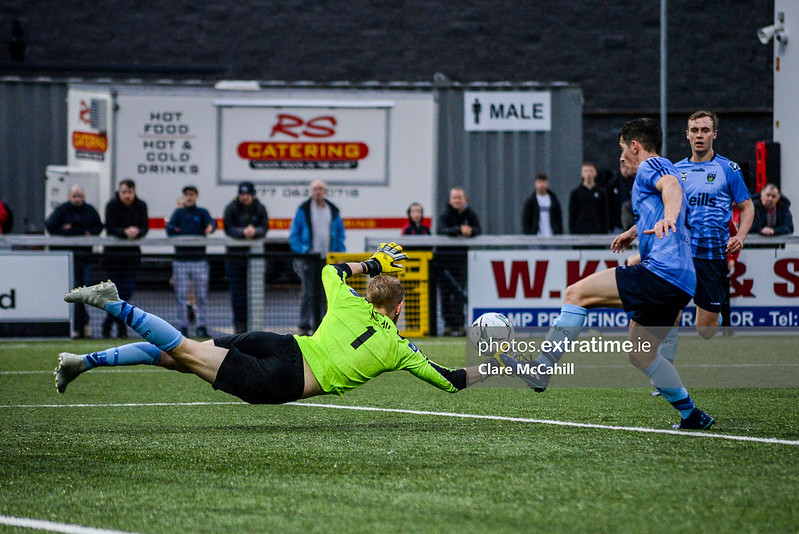LOI Premier Division Goalkeepers - A Deep Dive

A flying save Credit: Gerry Shanahan (ETPhotos)
Whisper it quietly, but there is a revolution underway in the League of Ireland Premier Division – and it is not concerned with flashy badges or the like.
We are talking about the number one difference, the difference in number ones, the goalkeeper.
Previously, the man between the sticks – in a League of Ireland context – was an established practitioner closing in on their thirties if not beyond.
But we are now looking at a much younger cohort for the majority of sides.
For over a decade, the Premier Division and FAI Cup Final winning starting goalkeepers were all well into their 30s – icons such as Gary Rogers, Mark McNulty and the ageless Alan Mannus (more on him later).
However, the past two seasons have seen stoppers barely into their 20s lift the FAI Cup aloft in their maiden season as a Premier Division number one.
The new age of goalkeepers
The average age of the ten Premier Division goalkeepers who played during the last weekend in March 2014 was just over 28. Meanwhile, the same weekend this season saw an average age of just over 25.
And if you take 40-year-old Alan Mannus (the oldest player by nine years and who wasn't in the league in 2014) out, another year can be sliced off.
While it is unlikely that the league will see the same drop in age continue over the next decade, it is nonetheless interesting to see that managers are placing their faith in younger keepers who are now a more integral part of the play than ever before.
After 7 league games, 7 of the 10 goalkeepers who started in goal on the opening Premier Division night had not missed a minute of league action. (40 year old Mannus the only one over 26 years of age)
The same number of seven was also true in the First Division. Of these seven, 4 were over the age of 26- Brendan Clarke (37), Wayne Guthrie (33), Lee Steacy (30) and Tim Heimer (28).
A red card given to Alex Moody (20) after an hour of a game between Bray Wanderers and Cobh prevented him becoming the eighth member of the full minute’s club.
Incidentally, Stephen McGuinness – who replaced Moody – saved a penalty with his first touch of the league season.
Spot kick specialists
McGuinness was one of two goalkeepers to save a penalty that evening with Athlone Town's Enda Minogue stop against Galway United the other.
While it was McGuinness' first piece of action in the division, it was the third time Minogue faced a spot kick in 2023 and Finn Harps' Ryan Rainey the only time he'd been beaten.
In the Premier Division, UCD's Kian Moore has faced 9 penalties in his senior career and saved three (33.3% save percentage).
That is a figure his rival for the starting position at the Belfield Bowl, Lorcan Healy, is also showing up this season – denying Pat Hoban before being beaten twice by Max Mata in the three penalties he's lined up for in the 2023 campaign.
Prior to this season, Healy nor Dundalk's Nathan Shepperd had saved a penalty in the League of Ireland- conceding 4 spot kicks each in 2022.
This season it's a save apiece from the four penalties in total faced- a 50% success rate for the pair of 22 year olds.
After seven rounds of the 2014 Premier Division season, nine penalties had been awarded with only one miss (88.8% conversion rate).
In 2016, six out of the eight taken by this point had been scored (75%) while, also by game seven, 2020 saw the conversion of five of the six penalties awarded (83.75%).
After 7 rounds this season there have been seven penalties of which only four have been scored (57.8%). (Source: Transfermarkt)
Goalscoring threats
Not only are goalkeepers adept at preventing penalties reaching the net, but they have found the net on occasions too.
But Brendan Clarke remains the last keeper to find the net in the League of Ireland thanks to his spot kick during St Patrick's Athletic September 2018 victory over former employers Sligo Rovers.
He is the last first-choice keeper under 30 to lift a Premier Division league title and the last to find the net.
Could either of these change this season? Only time will tell.
Assist kings
Goalkeepers have claimed assists in the Premier Division in the League of Ireland twice in the last few seasons.
Derry City's Brian Maher claimed one against UCD last season while former Sligo Rovers netminder Ed McGinty set up a goal for Junior Ogedi Uzokwe against Cork City in 2020.
The First Division also saw two goalkeeping assists that season as both Lorcan Healy and Lee Steacy contributed to goals for Liam Kerrigan (v Drogheda United) and Adam Evans (v Galway United) respectively.
Speaking of finding the net, a 2022 study carried out by Hernandez, Bastias and Ramirez into the actions of goalkeepers at the 2018 Men's World Cup concluded that goalkeepers were involved in more offensive than defensive actions by a ratio of 3:2.

Pass masters
Data from the following year in the League of Ireland shows a similar set of data with the 2019 Instat Report from the Premier Division recording an average of 32 passes per 90 minutes, of which 24 were considered attacking passes.
Though further investigation reveals that many of these were long passes, an average passing percentage of 78% shows that goalkeepers were equally as adept passers as their defensive counterparts.
Left and right backs both had a 78% pass completion rate with centre halves slightly more proficient at 79%.
Comparing this to the English Premier League and, according to a Sky Sports article by Adam Smith in 2020, the average passing percentage across goalkeepers in that league was 57%.
At the start of the 2022/23 season, a Duncan Alexander piece, under the Opta Analyst title, referenced half of all goalkeepers having a passing percentage of over 70% after the opening few games.
Within the 2019 Instat report, 11 of the 15 keepers who played in the Premier Division achieved a passing average of over 70% across the season.
Sweeper keepers
As well as the fundamentals of saving and accurate striking, many goalkeepers are now also expected to provide a sweeping type role.
Manuel Neuer is arguably the most famous proponent of this approach in recent times.
In the League of Ireland, both Bohemians and Dundalk are using this tactic with James Talbot and Nathan Shepperd having to leave their line 21 and 18 times respectively in their opening seven league games, according to Wyscout data.
Interestingly, the pair are two of only three keepers under 1.83m (6ft) height in the league – their smaller frame possibly lends itself to their ability of being sharper off their line.
In the 1950s, 1.73m (5' 7) Gyula Grosics was an integral part of an outstanding Hungary outfit and often contributed to their attacking moves, according to reports from the time.
A decade later, 1.8m (5'11) Tommy Lawrence won two league titles with Liverpool while Fabien Barthez – also 1.8m – claimed the World Cup and European Championships at the turn of the millennium and is the only goalkeeper under (1.83m, 6ft) to win the Premier League, sharing the record of shortest Champions League winning goalkeeper with Borussia Dortmund's Stefan Klos.
Grosics, Lawrence and Barthez displayed qualities of both speed and good decision making to contribute to their respective teams successes in the various periods over the past 70 years.
Today these similar assets are displayed by both Talbot and Shepperd in their League of Ireland careers, continuing the style of goalkeeping first brought to the world stage decades before any current League of Ireland manager was even born.

Conor Kearns: In focus
At 1.88m (6' 2) Shelbourne's Conor Kearns stands almost midway between the shortest (1.8m) and tallest (1.95m) keepers in the division.
After seven league games, these attributes translate to 15 excursions (3rd overall) while he currently stops 85.7% of the efforts he faces, almost a 13% improvement on his 2019 figure of 73% recorded while playing for UCD and, at the time of writing, has saved more shots this season than any other goalkeeper.
Despite Kearns' improvement in save percentage, on average, it has dropped across the Premier Division.
In 2019, the average save percentage in the Premier Division was 73%, this season it's 69.4% so far.
While clearly a different standard, to provide some element of context, within the big five European leagues only Marc André ter-Stegen's 88.7% save percentage ranks higher than Kearns' current output. (Source: fbref.com)
That is not to say that the Shels stopper is better than those others on the list but merely his performance within the League of Ireland context is at an extremely high level in comparison to how others are performing in their own leagues.
XG wars
With xG (expected Goals scored) now becoming an important part of data analysis in an attacking sense, at the other end of the field, expected goals conceded is a metric worthy of consideration as to how well a goalkeeper is performing.
In this area, Kearns has a league high 2.94 goal outperformance (that is to say he has prevented almost 3 goals more than was expected based on the quality of shot he has faced).
Again, for context, only 3 goalkeepers in the English Premier League are posting higher figures, though with 4 times as many league games played. (Source: fbref.com)
Once more, Shamrock Rovers' netminder Mannus is an outlier - having to stop more efforts now than four years ago, whereas most clubs have reduced the figure.
On average, in 2019, Premier Division goalkeepers faced a shot every 20.22 minutes while so far in 2023 it's every 22.63 minutes. (Sources: Instat 2019 and Wyscout 2023)
For Mannus, 2019 saw 34.7 minutes between efforts on goal, while he currently sees an effort on target every 21.4 minutes.
In 2019, Bohemians' James Talbot faced a shot every 23.86 minutes. So far this year it is 37.7 minutes, an average of just over 2 saves per game while having to leave his line on three occasions during the same time period.
Talbot has a save percentage of 72% in 2023 compared to his league high 83% of 2019.
However, despite this drop in save percentage, he is recording an xGA deficit of 0.08 per game. That means every in 25 games he's currently conceding two goals more than expected from shots faced.
However, given his multi-faceted role and the fact that he's ranked 4th in the league on this metric, any potential criticism must be tempered.
Saves, saves, and more saves
Derry City's Brian Maher (22) is 38.4 minutes between shots, down 10 minutes from his 2019's Candystripes predecessor Peter Cherrie (then aged 35) of 28.4 minutes. Maher, along with Kearns, the only two keepers to outperform their expected goals conceded metric.
Speaking of Kearns- while he faced an effort every 14 minutes when at UCD, it's now a little over 28 minutes between shots. Incidentally, the figure for the current UCD goalkeepers has this season increased slightly to one every 15 minutes.
For Cork City's Jimmy Corcoran it's almost 29 minutes between shots whereas his 2019 predecessors Mark McNulty and Tadhg Ryan spent an average of 21.4 minutes between shots.
Sligo Rovers' Luke McNicholas has faced a shot every 23.7 minutes on average, whereas the 2019 average for the Bit O'Red was every 17 minutes.
So, on average, Premier Division goalkeepers in the League of Ireland are now younger than those in 2014 and facing fewer shots, in general, than in 2019.
They appear to be more active in the build up to goals than ever before, though despite the assists outlined above, data is limited on this for the moment.

